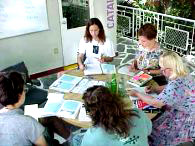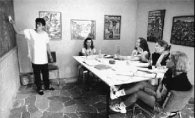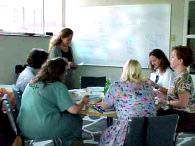|
Program & Admission Information - Cuernavaca, Mexico
|
|
|
|
|
|
|
The programs follow a well balanced model with an emphasis on speaking, listening, reading, and writing. There is an emphasis on oral competency, and teachers have been trained using the Oral Proficiency Guidelines of the American Council on the Teaching of Foreign Languages (ACTFL). All teachers are native speakers of Spanish, and have had extensive training in teaching Spanish as a second language to adult learners. Students at the beginning levels of Spanish will find themselves delightfully challenged by the program. Students at more advanced levels will also find the program to be equally engaging.
|
|
|
|
|
|
 Mexico and Mesoamerica. These Latin American studies classes are held for two or three hours per day, and are designed to compliment the students language classes. Topics include "Current Events in Mexico," "Mexico in the Twentieth Century," "Folk medicine and Traditional Healing," "Literature of the Revolution," and "Mesoamerican Religion." Additional supplementary workshops and topics on professional interests and specialized vocabulary can be included upon request.
Mexico and Mesoamerica. These Latin American studies classes are held for two or three hours per day, and are designed to compliment the students language classes. Topics include "Current Events in Mexico," "Mexico in the Twentieth Century," "Folk medicine and Traditional Healing," "Literature of the Revolution," and "Mesoamerican Religion." Additional supplementary workshops and topics on professional interests and specialized vocabulary can be included upon request.
Many "out of the classroom exercises" are included in the weekly program, and teachers frequently escort the students to nearby locations (the post office, the grocery store, a restaurant, etc.). The purpose of the teacher escorts is to help students build their vocabulary, learn situation-appropriate behaviors, and learn cultural language nuances. Classes emphasis the development of communicative skills, with stress placed on developing speaking and listening skills. Grammar exercises are embedded into the course to further develop these skills.
The Reading and Resources Room has a large collection of books, journals, and periodicals in both English and Spanish. Students are encouraged to coordinate a program of research along with their study of the Spanish language, and the members of the administration work closely with interested students to assist them in making valuable personal contacts in Mexico to further assist them in their research endeavors.
|
|
|
|
|
|
 Group, 20 hrs/wk
This program places a heavy emphasis on speaking Spanish and developing conversational skills. Classes are held daily, Monday through Friday, for 4 hours, and there are 4 additional hours of special needs sessions weekly.
Group, 20 hrs/wk
This program places a heavy emphasis on speaking Spanish and developing conversational skills. Classes are held daily, Monday through Friday, for 4 hours, and there are 4 additional hours of special needs sessions weekly.
Students are placed in classes according to their speaking proficiency in Spanish, and their language learning ability. Class groupings are refined, and change from time to time as students progress through the different levels. Group classes have 3-5 students per class allowing ample individual attention.
|
|
|
|
|
 Group, 30 hrs/wk
The program is designed for motivated people who want to learn the language and culture in an intensive manner. It consists of approximately 7 hours of daily group Spanish instruction, conversational practice and Latin American Studies, Monday through Friday. As in the Group 20 hrs/wk program, the number of students per group never exceeds 5, with an average of 3 students per class.
Group, 30 hrs/wk
The program is designed for motivated people who want to learn the language and culture in an intensive manner. It consists of approximately 7 hours of daily group Spanish instruction, conversational practice and Latin American Studies, Monday through Friday. As in the Group 20 hrs/wk program, the number of students per group never exceeds 5, with an average of 3 students per class.
Day - At - A - Glance
09:00 - 13:00, M-F Spanish classes
13:00 - 14:00, T & Th Conversation Assistance
13:00 - 19:00, M-Sa Use of Pool and facilities
16:00 - 17:15, M-Th Latin American Studies
18:00 - 19:00, Wed Conversation Exchange (upon request)
* Day-At-A-Glance is a sample day and will vary depending on enrollment, time of year, lodging, etc. It is designed to show content rather than precise scheduling
|
|
|
|
| |
|
Admissions & Academic Credit
|
|
|
|
Students age 17 years and older are welcomed regardless of educational background, occupation or nationality. Students under the age of 17 must be accompanied by an adult. No previous knowledge of Spanish is required except where otherwise indicated.
Students desiring credit for their study programs should contact their home school or request the NRCSA Credit Fact Sheet. Generally, U.S. universities consider 15 hours of study to be equal to 1 semester credit.
For more information about academic credit in Spanish speaking countries, please click here.
For general information on academic credit, please click here.
|
|
|
|
|
|
|

